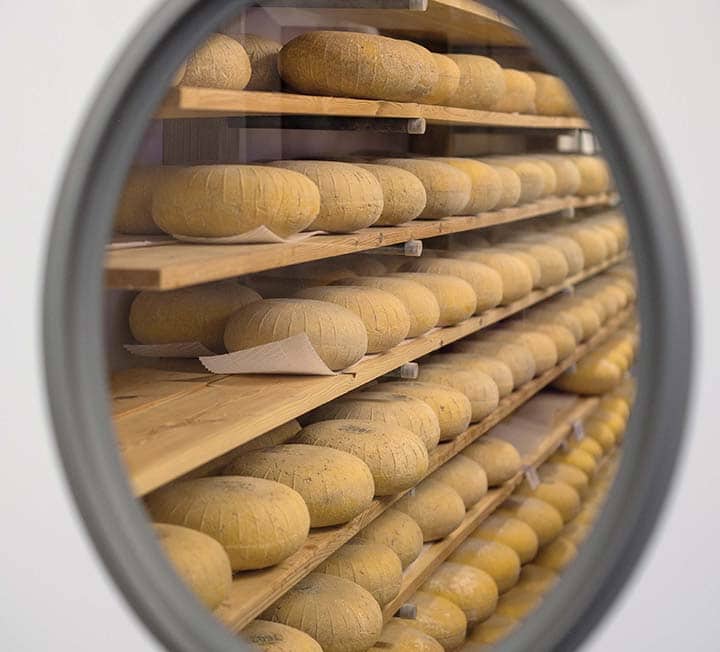Soft power
Cheese writer Emma Young on the soft, light, fresh-tasting cheeses of springtime


“THE ABUNDANCE OF SOFT, YOUNG GOAT AND SHEEP CHEESES IS IN HARMONY WITH SPRING’S EVER-LENGTHENING DAYS”
Words: Emma Young
The arrival of spring brings with it longer days, warmer weather (please) and a wider variety of exciting cheeses on cheesemongers’ counters.
Among approximately 6,000 other factors, some of my favourite aspects of cheese are batch variation and seasonality, and in particular the new additions we see gracing those counters in the springtime. Not all cheeses are made year-round. Most kidding and lambing occur at the beginning of the year, with kids and lambs galore creating adorable, destabilised chaos on farms when spring rolls around. With their arrival comes the natural start of milk production. This is why, at Borough Market, you will see an abundance of soft, young goat and sheep cheeses, in beautiful harmony with the season’s ever-lengthening days.
For Molly Powell of Mons Cheesemongers, the arrival of these spring cheeses gives her the dopamine hit needed after a cold, dreary British winter – a “fresh sense of optimism that spring has sprung somewhere”, and the relief that you can “experience it through food if not through the weather!” The most numerous spring additions come in the form of dainty, elegant cheeses which we cheese folk call ‘lactics’. These are made slowly and gently, with a lactic acid coagulation playing a key role in transforming the milk to curd, and then to cheese. These cheeses, which sometimes have wrinkly rinds, ash coats or a topping of herbs, come in a variety of shapes but are usually on the smaller side.

There are also cheeses that aren’t strictly seasonal, but whose character fits the mood at this time of year. During the warmer months our eating habits change and lighter, fresher meals are more welcome than powerful, full-flavoured, hearty dishes. I, for one, see a significant increase in my mozzarella di bufala consumption around now, and cheeses such as ricotta and stracchino start making cameos in my fridge. Fresh cheeses like these – cheeses that have seen little to no ageing – have flavours that are simple and representative of the milk (especially when made with raw milk) and haven’t developed the complex profile that come from long ageing and the controlled breakdown of components within the milk.
When you visit Borough Market, or any cheese shop, ask the cheesemongers if they have anything new and in season, but remember the classics also and don’t ever feel restrained to a certain style. I certainly never do. On a warm spring day, if you fancy a stilton instead of a goat’s cheese, no one will stop you – in fact you’ll be encouraged.
Here are a few of my favourite spring treats from this year:
BUCHETTE DE MANON

Buchette de Manon is a lactic goat’s cheese from Provence, available from Mons Cheesemongers. It is dainty and cylindrical in form – ‘buche’ means log, so a ‘buchette’ is a little log. Made by François and Vanessa Masto using the milk of their Rove goats, this has a gentle, elegant flavour profile, consciously minimal in its salt levels to allow the superlative milk flavour to really shine. It has a sprinkling of the herb ‘sarriette’ (savoury) on top and the texture ranges from soft and broken down, to a more structurally sound, whipped and aerated texture in younger batches.
CASTILLON FRAIS
How can a young, fresh, rindless cheese exude so much flavour? Castillon Frais, made by David and Fanette Ladu, is one of life’s mysteries. Also available from Mons Cheesemongers, it is a raw sheep’s milk cheese from Provence. It is so young and fresh that it arrives in vacuum-sealed bags and there are bumps on the surface of the cheeses that are still present from the holes in the drainage moulds they are formed in. Against all explanation this cheese has flavours of walnut & celery within – a veritable Waldorf salad! Castillon Frais can be (and in my house always is) eaten as it is, simply with a good baguette. It can however be used in a plethora of dishes – maybe crumble it over some roasted veg and potentially crack open a bottle of rosé with it if you’re feeling fruity.
GRACEBURN
This is a cheese which is not made seasonally, but really comes into its own at this time of year. Graceburn is a marinated, Persian fetta-style cheese made by Blackwoods Cheese Company in Kent. Graceburn’s marinade consists of cold-pressed English rapeseed oil, garlic, thyme and black pepper, making it, at times, taste like a full roast dinner – without the meat! Graceburn can be eaten as it is, drained from the jar, or eaten straight from the jar with a fork (this is my eating method of choice). It is perfect atop roasted vegetables or in any number of salads, and even in savoury pastries or as a addition to pasta or soup. I have yet to find a poor match. It even works with pickled onion Monster Munch (other crisp varieties are available).

PYGHTLE
Pyghtle (pronounced Pyh-tuhl) is a relatively new cheese on the British cheese scene, made by Emily Tydeman at Broughton Hall Farm in Suffolk. Emily makes unpasteurised sheep’s milk cheeses, cylindrical in shape with a wrinkly geotrichum (a yeast) rind. These cheeses are just back in season now, for their second year on the counters of Neal’s Yard Dairy. As they are new AND made with raw milk, the textures and nuances will vary throughout the season – something which should be celebrated. The batches which Neal’s Yard Dairy are receiving now are ricotta-like in texture – light and fluffy. Contrary to widespread belief, not all goat and sheep milk cheeses are strong and farmy, with this being a perfect example.
HEVER
Alongside these fresh, young seasonal beauties, we should still make sure we’re giving our attention to other styles of cheese. I love a wild card and my cheeseboards and selections will always keep you on your toes! Hever is a new cheese, also from Blackwoods Cheese Company, which has been in development for about a year, only really making its entrance onto the Market this spring. This is a washed-rind cheese, similar to a Burgundy classic. It is unashamedly bold, not hiding its inherent funk. Its texture is silky smooth, with a breakdown beneath the rind giving a secondary texture in the mouth. The flavours are brothy, savoury and meaty without going overboard. I highly recommend you seek this one out.
OTHERS TO SEEK OUT
The cheeses on Borough Market’s stands are ever-changing. There are some incredibly special cheeses there right now, including some at Brindisa from the Canary Islands, cheeses which have only just entered the UK market. Flavour-added cheeses can be gimmicky, but when they are executed properly they can be a thing of beauty, something that L’Ubriaco Drunk Cheese does well – for spring, look out for their Luna di Miele (a goat’s cheese in honey) and Vento D’Estate (a cow’s milk cheese in herbs and hay). For all your fresh cheese needs I cannot recommend highly enough The Parma Ham & Mozzarella Stand. Their cheeses are all impeccably sourced and I always head in their direction for my mozzarella di bufala, ricotta and occasional burrata needs.
The Cheese Wheel by Emma Young (Ebury Press) is available now from The Borough Market Store

